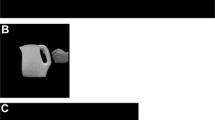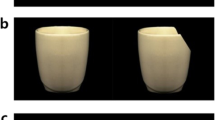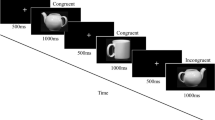Abstract
The Stroop-matching task is a variation of the Stroop task in which participants have to compare a Stroop stimulus attribute (color or word) to a second stimulus. The Stroop-matching response conflict (SMRC) represents an interference related to the processes involved in selection/execution of manual responses. In the present study, we developed a variation of the Stroop-matching task in which the Stroop stimuli were matched to graspable objects (a cup) with intact or broken handles laterally oriented (Experiment 1) or to colored bars laterally presented (Experiment 2). It allowed testing the presence of the correspondence effect for lateralized handles and bars and its possible influence on SMRC. Two different intervals (100 and 800 ms) were also included to investigate time modulations in behavioral performance (reaction time and accuracy). Fifty-five volunteers participated in the study. In both experiments, significant SMRC was found, but no interaction occurred between SMRC and correspondence effect, supporting that the hypothesis of different and relatively independent psychological mechanisms is at the basis of each effect. Because significant facilitation for ipsilateral motor responses (correspondence effect) occurred for graspable objects but not for lateralized bars, the attentional shift/spatial-coding view was not able to completely explain our data, and therefore, the grasping affordance hypothesis remained as the most plausible explanation. The time course of facilitation observed in the first experiment and by others indicates the importance of further studies to better understand the time dynamic of facilitation/inhibition of motor responses induced by graspable objects.




Similar content being viewed by others
References
Alluisi, E. A., & Warm, J. S. (1990). Things that go together: A review of stimulus–response compatibility and related effects. In R. W. Proctor & T. G. Reeve (Eds.), Stimulus response compatibility: An integrated perspective (pp. 3–30). Amsterdam: North Holland.
Anderson, S. J., Yamagishi, N., & Karavia, V. (2002). Attentional processes link perception and action. Proceedings of the Royal Society B Biological Sciences, 269(1497), 1225–1232. https://doi.org/10.1098/rspb.2002.1998.
Banich, M. T. (2009). Executive function: The search for an integrated account. Current Directions in Psychological Science, 18(2), 89–94. https://doi.org/10.1111/j.1467-8721.2009.01615.x.
Berlucchi, G. (2006). Inhibition of return: A phenomenon in search of a mechanism and a better name. Cognitive Neuropsychology, 23(7), 1065–1074. https://doi.org/10.1080/02643290600588426.
Buccino, G., Sato, M., Cattaneo, L., Rodà, F., & Riggio, L. (2009). Broken affordances, broken objects: A TMS study. Neuropsychologia, 47(14), 3074–3078. https://doi.org/10.1016/j.neuropsychologia.2009.07.003.
Caldas, A. L., David, I. P. A., Portes, P. M., Portugal, A. C. A., & Machado-Pinheiro, W. (2014). Order of stimulus presentation modulates interference in Stroop matching tasks: A reaction time study. Psicologia: Teoria e Prática, 16(3), 143–154. https://doi.org/10.15348/1980-6906/psicologia.v16n3p143-154.
Caldas, A. L., Machado-Pinheiro, W., Souza, L. B., Motta-Ribeiro, G. C., & David, I. A. (2012). The Stroop matching task presents conflict at both the response and nonresponse levels: An event-related potential and electromyography study. Psychophysiology, 49(9), 1215–1224. https://doi.org/10.1111/j.1469-8986.2012.01407.x.
Cardellicchio, P., Sinigaglia, C., & Costantini, M. (2011). The space of affordances: A TMS study. Neuropsychologia, 49(5), 1369–1372. https://doi.org/10.1016/j.neuropsychologia.2011.01.021.
Chajut, E., Schupak, A., & Algom, D. (2009). Are spatial and dimensional attention separate? Evidence from Posner, Stroop, and Eriksen tasks. Memory and Cognition, 7(6), 924–934. https://doi.org/10.3758/MC.37.6.924.
Chen, Z. (2003). Attentional focus, processing load, and Stroop interference. Perception and Psychophysics, 65, 888–900. https://doi.org/10.3758/BF03194822.
Chica, A. B., Bartolomeo, P., & Lupiáñez, J. (2013). Two cognitive and neural systems for endogenous and exogenous spatial attention. Behavioural Brain Research, 237, 107–123. https://doi.org/10.1016/j.bbr.2012.09.027.
Cho, D., & Proctor, R. W. (2010). The object-based Simon effect: Grasping affordance or relative location of the graspable part? Journal of Experimental Psychology: Human Perception and Performance, 36(4), 853–861. https://doi.org/10.1037/a0019328.
Cho, D., & Proctor, R. W. (2011). Correspondence effects for objects with opposing left and right protrusions. Journal of Experimental Psychology: Human Perception and Performance, 37, 737–749. https://doi.org/10.1037/a0021934.
Cho, D., & Proctor, R. W. (2013). Object-based correspondence effects for action-relevant and surface-property judgments with keypress responses: Evidence for a basis in spatial coding. Psychological Research, 77, 618–636. https://doi.org/10.1007/s00426-012-0458-4.
Choi, J. M., Cho, Y. S., & Proctor, R. W. (2009). Impaired color word processing at an unattended location: Evidence from a Stroop task combined with inhibition of return. Memory and Cognition, 37(6), 935–944. https://doi.org/10.3758/MC.37.6.935.
Craighero, L., Fadiga, L., Rizzolatti, G., & Umiltà, C. (1999). Action for perception: A motor-visual attentional effect. Journal of Experimental Psychology: Human Perception and Performance, 25(6), 1673–1692.
David, I. P. A., Volchan, E., Vila, J., Keil, A., Oliveira, L., Faria-Jr, A. J. P., … Machado-Pinheiro, W. (2011). Stroop matching task: Role of feature selection and temporal modulation. Experimental Brain Research, 208(4), 595–605. https://doi.org/10.1007/s00221-010-2507-9.
Diamond, A. (2013). Executive functions. Annual Reviews of Psychology, 64, 135–168. https://doi.org/10.1146/annurev-psych-113011-143750.
Dittrich, K., & Stahl, C. (2017). Two distinct patterns of interference in between-attributes Stroop matching tasks. Attention, Perception and Psychophysics, 79(2), 563–581. https://doi.org/10.3758/s13414-016-1253-x.
Fan, J., Mccandliss, B. D., Fossella, J., Flombaum, J. I., & Posner, M. I. (2005). The activation of attentional networks. Neuroimage, 26, 471–479. https://doi.org/10.1016/j.neuroimage.2005.02.004.
Fan, J., Mccandliss, B. D., Sommer, T., Raz, A., & Posner, M. I. (2002). Testing the efficiency and independence of attentional networks. Journal of Cognitive Neuroscience, 14, 340–347. https://doi.org/10.1162/089892902317361886.
Faul, F., Erdfelder, E., Lang, A.-G., & Buchner, A. (2007). G*Power 3: A flexible statistical power analysis program for the social, behavioral, and biomedical sciences. Behavior Research Methods, 39, 175–191. https://doi.org/10.3758/BF03193146.
Fischer, M. H., & Dahl, C. (2007). The time course of visuo-motor affordances. Experimental Brain Research, 176(3), 519–524. https://doi.org/10.1007/s00221-006-0781-3.
Friedman, N. P., & Miyake, A. (2017). Unity and diversity of executive functions: Individual differences as a window on cognitive structure. Cortex, 86, 186–204. https://doi.org/10.1016/j.cortex.2016.04.023.
Fukuda, K., & Vogel, E. K. (2011). Individual differences in recovery time from attentional capture. Psychological Science, 22(3), 361–368. https://doi.org/10.1177/0956797611398493.
Goldfarb, L., & Henik, A. (2006). New data analysis of the stroop matching task calls for a reevaluation of theory. Psychological Science, 17(2), 96–100. https://doi.org/10.1111/j.1467-9280.2006.01670.x.
Goslin, J., Dixon, T., Fischer, M. H., Cangelosi, A., & Ellis, R. (2012). Electrophysiological examination of embodiment in vision and action. Psychological Science, 23(2), 152–157. https://doi.org/10.1177/0956797611429578.
Grafton, S. T., Fadiga, L., Arbib, M. A., & Rizzolatti, G. (1997). Premotor cortex activation during observation and naming of familiar tools. Neuroimage, 6(4), 231–236. https://doi.org/10.1006/nimg.1997.0293.
Green, M. L., Locker, L., Jr., Boyer, T. W., & Sturz, B. R. (2016). Stroop-like interference in a match-to-sample task: Further evidence for semantic competition? Learning and Motivation, 56, 53–64. https://doi.org/10.1016/j.lmot.2016.09.003.
Hock, H. S., & Egeth, H. E. (1970). Verbal interference with encoding in a perceptual classification task. Journal of Experimental Psychology, 83, 299–303. https://doi.org/10.1037/h0028512.
Hommel, B. (1993). The role of attention for the Simon effect. Psychological Research, 55, 208–222. https://doi.org/10.1007/BF00419608.
Hommel, B. (2011). The Simon effect as tool and heuristic. Acta Psychologica, 136, 189–202. https://doi.org/10.1016/j.actpsy.2010.04.011.
Ishihara, S. (1972). Ishihara’s test for color-blindness. Tokyo: Kanehara.
Klein, R. M. (2000). Inhibition of return. Trends in Cognitive Sciences, 4(4), 138–147.
Lavie, N., Hirst, A., De Fockert, J. W., & Viding, E. (2004). Load theory of selective attention and congnitive control. Journal of Experimental Psychology: General, 133(3), 339–354. https://doi.org/10.1037/0096-3445.133.3.339.
Lavie, N., & Tsal, Y. (1994). Perceptual load as a major determinant of the locus of selection in visual attention. Perception and Psychophysics, 56, 183–197. https://doi.org/10.3758/BF03213897.
Lien, M. C., Jarin, E., & Proctor, R. W. (2013). An electrophysiological study of the object-based correspondence effect: Is the effect triggered by an intended grasping action? Attention, Perception and Psychophysics, 75(8), 1862–1882. https://doi.org/10.3758/s13414-013-0523-0.
Luo, C. R. (1999). Semantic competition as the basis of Stroop interference: Evidence from color-word matching task. Psychological Science, 10(1), 35–40. https://doi.org/10.1111/1467-9280.00103.
Lupiañez, J., Klein, R. M., & Bartolomeo, P. (2006). Inhibition of return: Twenty years after. Cognitive Neuropsychology, 23(7), 1003–1014. https://doi.org/10.1080/02643290600588095.
Machado-Pinheiro, W., Volchan, E., Vila, J., Dias, E. C., Alfradique, I., Oliveira, L., … David, I. P. A. (2010). Role of attention and translation in conflict resolution: Implications for Stroop matching task interference. Psychology and Neuroscience, 3(2), 141–150. https://doi.org/10.3922/j.psns.2010.2.003.
Macleod, C. M. (1991). Half a century of research on the Stroop effect: An integrative review. Psychological Bulletin, 109(2), 163–203. https://doi.org/10.1037/0033-2909.109.2.163.
Macleod, C. M., & Macdonald, P. A. (2000). Interdimensional interference in the Stroop effect: Uncovering the cognitive and neural anatomy of attention. Trends in Cognitive Science, 4(10), 383–391. https://doi.org/10.1016/S1364-6613(00)01530-8.
Makris, S., Hadar, A. A., & Yarrow, K. (2011). Viewing objects and planning actions: On the potentiation of grasping behaviours by visual objects. Brain and Cognition, 77, 257–264. https://doi.org/10.1016/j.bandc.2011.08.002.
Matheson, H. E., White, N. C., & Mcmullen, P. A. (2014). A test of the embodied simulation theory of object perception: Potentiation of responses to artifacts and animals. Psychological Research, 78(4), 465–482. https://doi.org/10.1007/s00426-013-0502-z.
Mcnair, N. A., Behrens, A. D., & Harris, I. M. (2017). Automatic recruitment of the motor system by undetected graspable objects: A motor-evoked potential study. Journal of Cognitive Neuroscience, 7, 1–13. https://doi.org/10.1162/jocn_a_01165.
Milham, M. P., Banich, M. T., Webb, A., Barad, V., Cohen, N. J., Wszalek, A. F., & Kramer, A. F. (2001). The relative involvement of anterior cingulate and prefrontal cortex in attentional control depends on nature of conflict. Cognitive Brain Research, 12(3), 467–473. https://doi.org/10.1016/S0926-6410(01)00076-3.
Murphy, S., Van Velzen, J., & De Fockert, J. W. (2012). The role of perceptual load in action affordance by ignored objects. Psychonomic Bulletin and Review, 19, 1122–1127. https://doi.org/10.3758/s13423-012-0299-6.
Nicoletti, R., Anzola, G. P., Luppino, G., Rizzolatti, G., & Umiltà, C. (1982). Spatial compatibility effects on the same side of the body midline. Journal of Experimental Psychology: Human Perception and Performance, 8, 664–673.
Oldfield, R. C. (1971). The assessment and analysis of handness: The Edinburg inventory. Neuropsychologia, 9(1), 97–113. https://doi.org/10.1016/0028-3932(71)90067-4.
Pappas, Z. (2014). Dissociating Simon and affordance compatibility effects: Silhouettes and photographs. Cognition, 133, 716–728. https://doi.org/10.1016/j.cognition.2014.08.018.
Phillips, J. C., & Ward, R. (2002). SR correspondence effects of irrelevant visual affordance: Time course and specificity of response activation. Visual Cognition, 9(4–5), 540–558. https://doi.org/10.1080/13506280143000575.
Posner, M. I., & Cohen, Y. (1984). Components of visual orienting. In H. Bouma & D. Bowhuis (Eds.), Attention and performance X (pp. 531–556). Hillsdale: Erlbaum.
Posner, M. I., & Digirolamo, G. J. (1998). Executive attention: Conflict, target detection, and cognitive control. In R. Parasuraman (Ed.), The attentive brain (pp. 401–423). Cambridge: MIT Press.
Proctor, R. W., Lien, M.-C., & Thompson, L. (2017). Do silhouettes and photographs produce fundamentally different object based correspondence effects? Cognition, 169, 91–101. https://doi.org/10.1016/j.cognition.2017.08.009.
Proctor, R. W., & Vu, K. P. L. (2006). Stimulus–response compatibility principles: Data, theory and application. Boca Raton: CRC Press.
Riggio, L., Patteri, I., Oppo, A., Buccino, G., & Umiltà, C. (2006). The role of affordances in inhibition of return. Psychonomic Bulletin and Review, 13(6), 1085–1090. https://doi.org/10.3758/BF03213930.
Simon, J. R. (1990). The effects of an irrelevant directional cue on human information processing. In R. W. Proctor & T. G. Reeve (Eds.), Stimulus–response compatibility: An integrated perspective (pp. 31–86). Amsterdam: North-Holland.
Stahl, C., Voss, A., Schmitz, F., Nuszbaum, M., Tüscher, O., Lieb, K., & Klauer, K. C. (2014). Behavioral components of impulsivity. Journal of Experimental Psychology: General, 143(2), 850–886. https://doi.org/10.1037/a0033981.
Stroop, J. R. (1935). Studies of interference in serial verbal reactions. Journal of Experimental Psychology, 18(6), 643–662. https://doi.org/10.1037/h0054651.
Sturz, B. R., Green, M. L., Locker, L., Jr., & Boyer, T. W. (2013). Stroop interference in a delayed match-to-sample task: Evidence for semantic competition. Frontiers in Psychology: Cognition, 4, 842. https://doi.org/10.3389/fpsyg.2013.00842.
Symes, E., Ellis, R., & Tucker, M. (2005). Dissociating object-based and space-based affordances. Visual Cognition, 12, 1337–1361. https://doi.org/10.1080/13506280444000445.
Symes, E., Ellis, R., & Tucker, M. (2007). Visual object affordances: Object orientation. Acta Psychologica, 124, 238–255. https://doi.org/10.1016/j.actpsy.2006.03.005.
Tipper, S. P., Paul, M. A., & Hayes, A. E. (2006). Vision for action: The effects of object property discrimination and action state on affordance Simon effects. Psychonomic Bulletin and Review, 13, 493–498. https://doi.org/10.3758/BF03193875.
Treisman, A., & Fearnley, S. (1969). The Stroop test: Selective attention to colours and words. Nature, 222(5192), 437–439. https://doi.org/10.1038/222437a0.
Tucker, M., & Ellis, R. (1998). On the relations between seen objects and components of potential actions. Journal of Experimental Psychology: Human Perception and Performance, 24(3), 830–846. https://doi.org/10.1037/0096-1523.24.3.830.
Van Veen, V., & Carter, C. S. (2005). Separating semantic conflict and response conflict in the Stroop task: A functional MRI study. Neuroimage, 27(3), 497–504. https://doi.org/10.1016/j.neuroimage.2005.04.042.
Vivas, A. B., & Fuentes, L. J. (2001). Stroop interference is affected in IOR. Psychonomic Bulletin and Review, 8, 315–323. https://doi.org/10.3758/BF03196167.
Williams, E. (1977). The effects of amount of information in the Stroop color word test. Perception and Psychophysics, 22(5), 463–470. https://doi.org/10.3758/BF03199512.
Acknowledgements
The authors thank Dr. Bernhard Hommel and two anonymous reviewers for their very helpful suggestions to improve an earlier version of this manuscript.
Funding
This study was funded by FAPERJ (Grant number E-26/110.239/2011). Funding was provided by CNPq, CAPES, PROPPi/UFF.
Author information
Authors and Affiliations
Corresponding author
Ethics declarations
Conflict of interest
Author Ariane Leão Caldas declares that she has no conflict of interest. Author Walter Machado-Pinheiro declares that he has no conflict of interest. Author Olga Daneyko declares that she has no conflict of interest. Author Lucia Riggio declares that she has no conflict of interest.
Ethical approval
All procedures performed in this study, which involved human participants were in accordance with the ethical standards of the institutional and/or national research committee and with the 1964 Helsinki declaration and its later amendments or comparable ethical standards.
Informed consent
Informed consent was obtained from all individual participants included in the study.
Additional information
Publisher's Note
Springer Nature remains neutral with regard to jurisdictional claims in published maps and institutional affiliations.
Rights and permissions
About this article
Cite this article
Caldas, A.L., Machado-Pinheiro, W., Daneyko, O. et al. The Stroop-matching task as a tool to study the correspondence effect using images of graspable and non-graspable objects. Psychological Research 84, 1815–1828 (2020). https://doi.org/10.1007/s00426-019-01191-5
Received:
Accepted:
Published:
Issue Date:
DOI: https://doi.org/10.1007/s00426-019-01191-5




